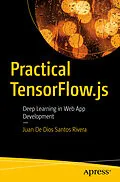Develop and deploy deep learning web apps using the TensorFlow.js library. TensorFlow. js is part of a bigger framework named TensorFlow, which has many tools that supplement it, such as TensorBoard , ml5js , tfjs-vis. This book will cover all these technologies and show they integrate with TensorFlow. js to create intelligent web apps.
- Build deep learning products suitable for web browsers
- Work with deep learning algorithms such as feedforward neural networks, convolutional neural networks (CNN), recurrent neural networks (RNN), and generative adversarial network (GAN)
- Develop apps using image classification, natural language processing, object detection, dimensionality reduction, image translation, transfer learning, and time series analysis
Autorentext
Juan De Dios Santos Rivera is a machine learning engineer who focuses on building data-driven and machine learning-driven platforms. As a Big Data Software Engineer for mobile apps, his role has been to build solutions to detect spammers and avoid the proliferation of them. This book goes hand-to-hand with that role in building data solutions. As the AI field keeps growing, developers need to keep extending the reach of our products to every platform out there, which includes web browsers.
Inhalt
Chapter 1
Welcome to TensorFlow.js
Headings
What is TensorFlow.js?
TensorFlow.js API
Tensors
Operations Variables
How to install it
Use cases
Chapter 2
Building your First Model
Headings
Building a logistic regression classification model
Building a linear regression model
Doing unsupervised learning with k-means
Dimensionality reduction and visualization with t-SNE and d3.js
Our first neural network
Chapter 3
Create a drawing app to predict handwritten digits using
Convolutional Neural Networks and MNIST
Headings
Convolutional Neural Networks
The MNIST Dataset
Design the model architecture
Train the model
Evaluate the model
Build the drawing app
Integrate the model within the app
Chapter 4
"Move your body!" A game featuring PoseNet, a pose estimator model
Headings
What is PoseNet?
Loading the model
Interpreting the result
Building a game around it
Chapter 5
Detect yourself in real-time using an object detection model trained in
Google Cloud's AutoML
Headings
TensorFlow Object Detection API
Google Cloud's AutoML
Training the model
Exporting the model and importing it in TensorFlow.js
Building the webcam app
Chapter 6
Transfer Learning with Image Classifier and Voice Recognition
Headings
What's Transfer Learning?
MobileNet and ImageNet (MobileNet is the base model and ImageNet is the training set)
Transferring the knowledge
Re-training the model
Testing the model with a video
Chapter 7
Censor food you do not like with pix2pix, Generative Adversarial
Networks, and ml5.js
Headings
Introduction to Generative Adversarial Networks
What is image translation?
Training your custom image translator with pix2pix
Deploying the model with ml5.js
Chapter 8
Detect toxic words from a Chrome Extension using a Universal
Sentence Encoder
Headings
Toxicity classifier
Training the model
Testing the model
Integrating the model in a Chrome Exte...
